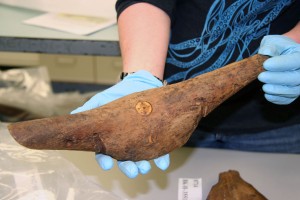Research reveals oldest known circumpolar umiak
December 11, 2012

907-474-6941
12/11/12
The remains of an umiak discovered among a recent acquisition at the University of Alaska Museum of the North have been dated at 1,000 years old, the oldest skin boat assembly in the circumpolar North.
Anchorage Museum researcher Jenya Anichenko identified the pieces during a trip to Fairbanks earlier this year to work with the Birnirk collection as part of her research on circumpolar open skin boats.
“Skin boats persevere in the archaeological record, but usually as unrelated fragments of the frame,” Anichenko said. “Skin boat assemblages are extremely rare in the circumpolar archaeological record. These pieces are unique because they all belong to the same boat and are 400 years older than what we’ve seen so far.”
The importance of the Birnirk archaeological site near Barrow was immediately recognized when it was discovered in the 1930s, but a full analysis was never published. The site was first excavated by James Ford of the United States National Museum and later by a Harvard University expedition directed by Wilbert Carter. Several boat finds were mentioned in Ford’s publication, but Anichenko wanted to learn more.

Working with these fragments is similar to forensic research, she said. “You are attempting to understand thousands of years of technical evolution on the basis of one piece of the puzzle.”
By Anichenko’s count, the Birnirk’s umiak collection includes 30 wooden fragments, ranging from keel timber and bottom cross pieces to small fragments of baleen lashing. A National Science Foundation grant allowed for radiocarbon dating of three samples, one side rib and two of the umiak’s bottom crosspieces. The shortest crosspiece likely represents the cross-bottom timber nearest to the stern or stem post. The artifact is embellished with three oval ivory inlays held in place with small ivory pins.
“These lack an immediate functional meaning, which implies they were used as decoration or had ritual significance,” Anichenko said.
The Birnirk materials excavated by Carter are owned by the U.S. Navy and were housed for decades at the Harvard Peabody Museum. In 2011, the Carter collections returned to Alaska and are presently curated at the University of Alaska Museum of the North.
Scott Shirar, the museum’s research archaeologist, said the return of this collection to Alaska has tremendous potential.
“The level of preservation at the Birnirk site was tremendous,” he said. “Many of the organic artifacts usually not preserved in the archaeological record were preserved at this site.”
Organic artifacts, such as wooden boat pieces or other tools made from fur, leather, ivory, or bone, tend to disappear over the course of a couple thousand years. The standard clues used to piece together the past usually come from more durable stone artifact types.
Shirar said the wide range of artifacts and material types in this collection will support a wide variety of interests. Anichenko’s work on skin boats is just the beginning.
“Now that this collection is back in Alaska and at the UA Museum of the North, researchers have the opportunity to access many untold stories just waiting to be discovered,” he said.
ADDITIONAL CONTACTS: Jenya Anichenko, special exhibits curator at the Anchorage Museum, at 907-929-9270 or via email at janichenko@anchoragemuseum.org and Scott Shirar, UAMN research archaeologist, at 907-474-6943 or via email at sjshirar@alaska.edu.
ON THE WEB: museum.uaf.edu
TB/12-11-12/148-13


